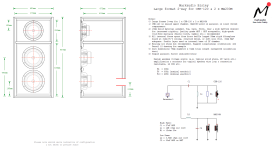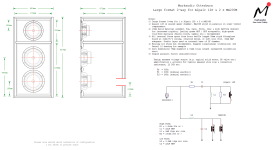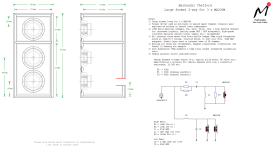What do you think about CHP90 instead Vifa P13WH? Would it work in Ariels?
You’d want to model a new line. Ariels were a succession of physical prototypes leading to a complex line.
Put 2 CHP in series with a big shunt cap across one should work well.
dave
Last edited:
While we're on the subject (well, not really, but it's my dumping ground thread 😉 ) I was asked for a Neptune series design for MA200. Since Neptune itself was created for the now-defunct Alpair 12PW, I've recycled the name into MkII format, or the nominal series naming structure wouldn't make much sense. Bailey / Augspurger style damped LF alignment, no more than 1dB passband ripple at F3 & F5, so very much in line with those '60s - early '70s designs. Dry as a martini.
Attachments
May I ask what F3,F5,F6,Fb mean?
I saw Maop10.2 chambered truncated tl has
Fb=54Hz and didn't show for alpair10m,10p.
Also for Hidden peak,pdf shows fb=42hz,F6=36hz.
Why Fb is higher on chambered truncated tl?
I saw Maop10.2 chambered truncated tl has
Fb=54Hz and didn't show for alpair10m,10p.
Also for Hidden peak,pdf shows fb=42hz,F6=36hz.
Why Fb is higher on chambered truncated tl?
Fb = system tuning frequency.
F3 = 3rd harmonic, F5 = 5th harmonic
F6 = -6dB LF frequency
They're designed to completely different LF alignments; not everybody wants the same thing for various reasons, so the object is to provide a reasonable range of enclosures to cater to as as many of those requirements as practical.
F3 = 3rd harmonic, F5 = 5th harmonic
F6 = -6dB LF frequency
They're designed to completely different LF alignments; not everybody wants the same thing for various reasons, so the object is to provide a reasonable range of enclosures to cater to as as many of those requirements as practical.
Still doing some work on the Ariels; apologies [in the unlikely event anybody cares 😉 ] it's taking a while, but I'd rather get it right as far as I can do in terms of the spirit of the original design -load, price, low linear distortion on a Harwood type curve, low IM distortion (less of an issue in '25 with some [some] well-chosen tweeters) than it was in the mid-late '90s etc.
In the meantime: three simple larger format MA 2-ways for grins. Same enclosure used for each, different response balance (more LF-biased with CHR-120, roughly neutral with Alpair 12P, lurking somewhere in between but closer to the latter with MA200). Named for UK MOD artillery ranges & vaguely inspired by the evergreen Tannoy Buckingham. Amongst others. Filtering is one of my favourite trad. solutions (since these are by intent trad. type boxes) & based on an offset 2nd order Butterworth; we're targeting power-response & a relatively rich / 'vintage' balance here, so if if your priorities lie elsewhere, other options are likely to serve you better.
In the meantime: three simple larger format MA 2-ways for grins. Same enclosure used for each, different response balance (more LF-biased with CHR-120, roughly neutral with Alpair 12P, lurking somewhere in between but closer to the latter with MA200). Named for UK MOD artillery ranges & vaguely inspired by the evergreen Tannoy Buckingham. Amongst others. Filtering is one of my favourite trad. solutions (since these are by intent trad. type boxes) & based on an offset 2nd order Butterworth; we're targeting power-response & a relatively rich / 'vintage' balance here, so if if your priorities lie elsewhere, other options are likely to serve you better.
Attachments
@Scottmoose don't you think a smaller driver for the high part of the range ould be better than "big" drivers chr120, alpair 12p? or a double small chn 50p to follow MA200?
@Pierrick59
If you look at that way, you could also argue that it is better to find two truly midbass drivers instead of MA200.
But, the beauty of it was to make it as Scott did. Not the cheapest solution, sure, but...there is some appeal to it 😉
If you look at that way, you could also argue that it is better to find two truly midbass drivers instead of MA200.
But, the beauty of it was to make it as Scott did. Not the cheapest solution, sure, but...there is some appeal to it 😉
my logic tell use smaller driver to be more adapted to high frequencies. yes i see that the economic is not the mind of theses conceptions.
i ask question because i have ordered my MA 200 pair i will receive them in few weeks i still don't know what i will build...
i have not space FH XL...
i ask question because i have ordered my MA 200 pair i will receive them in few weeks i still don't know what i will build...
i have not space FH XL...
Writing this as a literal explanation -it's not intended to be offensive:
These designs, per my post, are specifically intended to be a larger format type. They're meant to fulfull that role / niche / set of requirements, not something different. That's why I said: 'if your priorities lie elsewhere, other options are likely to serve you better' (and visa versa). I've already done a few of those; these three are for the people who want larger units.
These designs, per my post, are specifically intended to be a larger format type. They're meant to fulfull that role / niche / set of requirements, not something different. That's why I said: 'if your priorities lie elsewhere, other options are likely to serve you better' (and visa versa). I've already done a few of those; these three are for the people who want larger units.
Last edited:
For reference (already on this thread IIRC) this is the simple MTM I did for MA200M and a CHN-50 for those who want a smaller mid-tweet. And a smaller (also intentionally simple) standmount with MAOP 5.
https://www.markaudio.com/wp-content/uploads/2024/11/MA200M-CHN50-MTM.png
https://www.markaudio.com/wp-content/uploads/2024/10/MAOP5MA200M-standmount-.png
https://www.markaudio.com/wp-content/uploads/2024/11/MA200M-CHN50-MTM.png
https://www.markaudio.com/wp-content/uploads/2024/10/MAOP5MA200M-standmount-.png
What worries me is that several of your designs use 2 MA200s and I only bought one pair 😉
Last edited:
That's easy to solve. Buy one more pair 😉 🙂What worries me is that several of your designs use 2 MA200s and I only bought one pair 😉
I found out why it is always better to buy more expensive speakers:
In the beginning, it hurts, but after a few years you forget how much you paid for them and enjoy the good sound.
On the contrary, you buy cheap drivers, and even after a few years get reminded that you did not pay enough! 🤣
In the beginning, it hurts, but after a few years you forget how much you paid for them and enjoy the good sound.
On the contrary, you buy cheap drivers, and even after a few years get reminded that you did not pay enough! 🤣
@Scottmoose There's no blame, don't worry, your work is great.
Since the MA 200 is your baby, out of all the enclosures designs, which one did you build for yourself?
Since the MA 200 is your baby, out of all the enclosures designs, which one did you build for yourself?
Not my baby, Evan's. I just made a contribution, for whatever it was worth, to deciding some general characteristics, particularly its EM parameters. One voice amongst several.
All the enclosures are tested -we don't put out anything that isn't.
All the enclosures are tested -we don't put out anything that isn't.
Truth there. There are some bargins to be had if you know where to look & how best to use them, but sadly few & far between...I found out why it is always better to buy more expensive speakers:
In the beginning, it hurts, but after a few years you forget how much you paid for them and enjoy the good sound.
On the contrary, you buy cheap drivers, and even after a few years get reminded that you did not pay enough! 🤣
- Home
- Loudspeakers
- Full Range
- Miscellaneous designs - Markaudio, Fostex, TB, Dayton, SEAS etc




